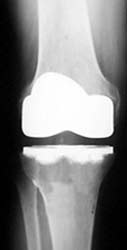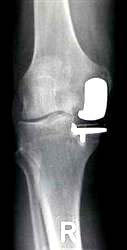General Questions
What is the difference between total knee replacement and partial knee replacement (unicompartmental knee replacement)?
|
Compare these two x-rays to see the main mechanical difference.
To learn about the functional and/or procedural differences read more in this FAQ and in the total knee replacement FAQ and discuss the topic with your doctor.
|
 |
 |
| Total Knee |
Partial Knee |
|
Why should I consider this procedure?
The primary purpose of this procedure is relief of pain. Second is to enhance walking ability. Finally, restoring anatomy as close as possible to normal. The prosthesis is designed for walking or brisk walking, not running.
What is a mobile/fixed bearing implant?
The partial knee replacement usually consists of essentially three pieces, the two metal alloy pieces that are attached to the bone and a very strong plastic insert that serves as the 'bearing' to help the knee turn. In a fixed-knee prosthesis, the plastic insert is held in place by a metal locking system attached to the metal piece on the lower leg (tibia). In a mobile bearing system the plastic insert is able to rotate for potentially longer performance with less wear. Talk to your doctor about which one is right for you.
What is the Oxford Knee?
The Oxford knee is an artificial joint utilizing the mobile bearing system.
The Procedure
Do I need to donate blood for total knee surgery?
This operation will lead to some blood loss. Usually, this is between 20 and 200 ml. Most often, blood transfusion is not necessary. Rarely complications during surgery can lead to rapid blood loss and require a blood transfusion. If this concerns you then you should discuss this possibility with your doctor.
What type of anaesthetic will I have? Should I use a general or local anesthetic?
A general anasthetic means you will be unconscious during the surgery and should have no recollection aside from going to sleep and waking up. A local anasthetic allow you to remain conscious. Typically we use a spinal anesthetic which blocks all pain in the area while leaving the patient conscious. This is a personal choice and can be discussed with the anesthesiologist.
After the Procedure
What type of activities can I participate in after a partial knee replacement? What will be the range of motion in my knee?
Final range of motion in compartment procedures is usually comparable to preoperative range of motion.
What is the recovery time? How long will it be before I can a) walk without pain or b) go back to work?
Usually, full weight bearing is allowed immediately after the operation. Mobilization after surgery is important to prevent complications (deep venous thrombosis/pulmonary embolism) and to resume independent self-care as soon as possible.
Can I return to playing sports after surgery?
The prosthesis is designed for walking/brisk walking - not running. That said, it is possible that some low impact exercises that avoid pivoting and twisting may be advantageous. Consult your doctor for specific information.
Will I have to wear a brace after surgery?
A brace is usually not required.
Is the oxford procedure acceptable when you have osteonecrosis in the knee?
The Oxford procedure can be very successful for treatment of osteonecrosis of the knee, as this process typically destroys a very limited area of the knee. Replacing this with a partial knee replacement, with the remaining knee structures intact, is often one of the best strategies for treatment
What is the best knee replacement option?
The Oxford knee appears to have the best track record. If you follow the links on my website, information regarding statistics and studies can be found on the Oxford website.
Is the Oxford Knee available in the United States?
Yes, the Oxford partial knee replacement is available in the United States.
I have checked into a method call a unispacer. In talking with an orthopedic surgeon about that method I was told that one of the frequent problems is that with sports use it pops out and requires surgery to remove it. Is there something in the Oxford method that prevents the moving medial "plastic" from coming out?
The unispacer is a metal implant that requires very little bone resection.
The results of this implant have not been widely distributed, despite many implantations. I have actively tried to obtain good outcome data over the last 6 months or so, these are not readily available. The manufacturer/ distributor has been of no help. I spoke to a clinical investigator in a trial with this implant, who also could not give me much detail.
The main issues appear to be inconsistent pain relief, perhaps related to the stiffness of the metal implant, as well as dislocation.
In the Oxford mobile bearing knee the risk of dislocation of the mobile bearing (medial side) is thought to be approximately 1 %, usually during the first year. This typically is not associated with sporting activities, but happens when the leg is relaxed near full extension, such as when lying in bed or sitting in a reclining chair.
The Oxford knee is not really designed for extreme sporting activcities, such as long distance running, contact sports etc. Many people return to recreational tennis, golf, brisk walking, cycling, swimming etc.
Has a partial replacement got the same life expectancy as a full replacement? And based on this, would you opt for a partial or full replacement?
An Oxford medial unicompartmental knee replacement has been shown to have over 95% survival of the implant at 10 years, if appropriate screening was done prior to the surgery. "Screening" means that it was ascertained that the lateral compartment was preserved and that the cruciate ligaments were intact.
This compares to the best total knee results.
Furthermore, it appears that if a revision is necessary, i.e. in the 5% of patients that develop a problem during the first 10 years, taking a unicompartmental knee replacement out and replacing it with a total knee replacement is less of an operation and has better results than taking a total knee replacement being replaced by another total knee replacement.
Therefore, the strategy utilizing a smaller prosthesis, i.e. unicompartmental knee replacement, as the first procedure, is predicted to give similar outcomes and better revision options than using a total knee replacement as the first procedure.
It minimizes "burning your bridges".